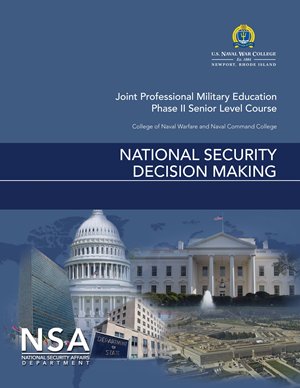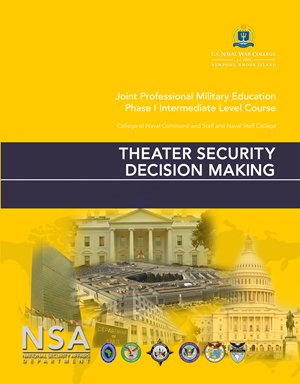National Security Affairs Department
The National Security Affairs (NSA) department at U.S. Naval War College (NWC) is one of the nation's largest and most vibrant graduate departments teaching foreign policy analysis and international security. We provide professional education to mid- and senior-career students who are military and civilian national security professionals from the United States and more than 60 partner countries.
Graduate-Level Security Studies
The NSA department offers two courses that lead to the master's degree and Joint Professional Military Education credit: national security decision making (NSDM) for senior-ranking students and theater security decision making (TSDM) for mid-ranking students. These courses provide a broad interdisciplinary foundation in contemporary security studies to analyze how the U.S. government makes foreign policy decisions and the role the U.S. plays in the world.
National Security Decision Making Course
Upon completing the National Security Decision Making (NSDM) course, you will be prepared to serve on Service and Joint staffs to operate at the national level. You’ll leave the course with:
- the ability to develop and communicate analyses of current and emerging security issues facing the U.S. and its international partners and allies
- the understanding of U.S. decision making dynamics at the strategic level
- the ability to assess political, budgetary, bureaucratic, organizational, and leadership factors influencing decision making and implementation of U.S. foreign policy and strategy development
NSDM Capstone Final Exercise (FX)
Click to Open
At the end of NSDM, each seminar acts as a national strategic planning working group to produce and present a capstone FX. Student seminars simulate the work of a national strategic planning team in which the objective is to produce an executive-level strategic estimate of the longer-term future global security environment and the main tenants of a national security strategy and a nested national military strategy to advance U.S. national interests in this future environment. They must also develop operating concepts for how the future joint force will operate, a joint force structure within budget constraints, and an implementation case study.
Each FX includes:
- Executive-level global strategic estimate of the future security environment over the next 20 years;
- National security strategy and national military strategy that advances and defends U.S. national interests;
- Operating concepts that describe how the future force will operate;
- Joint force structure within budget guidance;
- Implementation case
Theater Security Decision Making Course
Upon completing the Theater Security Decision Making (TSDM) course, you will be prepared to serve in combatant commands and their components to advance and defend national interests at the regional level. You’ll leave the course with:
- the ability to formulate and communicate assessments of a regional security environment, develop regional strategy using all tools of power, and identify capability gaps to advance and defend national interests
- the understanding of U.S. decision making dynamics at the regional level
- the ability to assess political, budgetary, bureaucratic, organizational, and leadership factors influencing decision making and implementation of U.S. foreign policy and strategy
TSDM Capstone Final Exercise (FX)
Click to Open
At the end of TSDM, each seminar acts as a geographic combatant command working group to produce and present a capstone FX. Student seminars simulate the role of a theater strategic planning team for a geographic combatant command (GCC). Each seminar develops and presents an executive-level strategic estimate of the near-term regional security environment for one of five GCCs, the main tenants of a theater strategy that advances U.S. national interests, a priority list of capabilities needed to advance that strategy, and an implementation case study.
Each FX includes:
- Executive-level strategic estimate of the future security environment in the theater over the next eight years;
- Outline of a theater strategy;
- Integrated priority list (IPL) necessary to advance the strategy;
- Implementation details on one aspect of the strategy or the IPL to describe how the innovation or idea would be executed;
- Performance measures.
Our Faculty
The department is first and foremost a teaching department where scholars and national security practitioners follow a curriculum that combines academic rigor with policy relevance. To further this, faculty participate in scholarly, policy and professional activities to ensure students have a learning experience that meets the needs of the Navy and the intent of the Joint Professional Military Education (JPME) system.
Visit Faculty
Here are recent selections of NSA faculty contributions to the broader national and international security discourse.
Faculty Articles
Click to Open
In addition to authoring a broad range of books and scholarly articles in industry-leading journals and world-renowned publications, our faculty frequently contribute to and serve as a trusted source of analysis and expert opinion for hundreds of local, regional, national, and international news and media outlets.
Explore Faculty Articles
Student Publications
Click to Open
Redesigning the United States–Philippines Security Partnership: A Nodal Defense Approach to the Indo-Pacific
CDR Marie Angelica De Castro Sisican, Philippine Navy / Sept. 21, 2023
Baltic Sea Mining as an Extension of the Russian Gray Zone
Victor Duenow / April 18, 2022
Black Mirror Statecraft: Combating PRC Hostile Social Manipulation and Sharp Power in an Era of Great Power Competition
Jonathan Lushenko / February 18, 2022
Indo-Pacific Demographic Shifts: Effects of the Demographics in China and India on the Regional Security Environment
LT Sam Melick, USN / March 08, 2021
Harnessing the Power of Information: A Better Approach for Countering Chinese Coercion
MAJ Kurt Stahl, USMC / Feb. 10, 2021
Don’t Gamble on the Next Space Race: Win in the Orbital Gray Zone Now
Jim Malachowski / January 31, 2021
Tumultuous Trade Relations Have Created an Exit Door and Opportunity for America
CDR Daniel Kwiatkowski, USN / June 2, 2020
The Territorialization of Airspace in the East and South China Seas
Scott Thornbury / April 29, 2020
China's Belt and Road Initiative Is Stoking Tensions with India
LCDR Mitchell J. Hays, USN / November 16, 2017
Japan's Military Provides America with New Strategic Options
MAJ Jonathan W. Kuntz, USAF / November 1, 2017
Booming Baluchistan: Who Benefits from These Lucrative Trade Routes?
LCDR Jeff Palmer, USN / August 8, 2016
Conditional Deterrence and Missile Defense
John Gibilterra / Feb 25, 2015
The Defense-Research Culture Clash
Andrew Snowdon / April 2, 2013
The Insider Threat to Airport Security
Steven Goff, USNR / March 14, 2013
Our Arctic Strategy Deficit
William Edwards / Mar 8, 2013
A Great White Fleet for the 21st Century
David K. Richardson, Lane V. Packwood, Daniel E. Aldana / Jan 1, 2008




